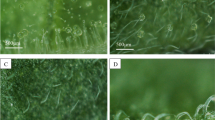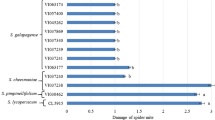Abstract
Tomatoes of the Micro-Tom cultivar, Solanum lycopersicum L. (Solanaceae), are small, have a short life cycle, high-density growth, high-efficiency protocols for genetic transformation, and hormonal and morphological mutants. These characteristics make this cultivar a good candidate as a helpful tool in resistance studies against the whitefly, Bemisia tabaci (Gennadius 1889) (Hemiptera: Aleyrodidae). The insect behavior in the Micro-Tom cultivar was observed through free-choice and no-choice oviposition preference tests and life cycle in lab conditions, having as reference the Santa Clara cultivar. In these tests, behavioral and biological insect parameters were obtained and the purpose was used to assess the trichome absence effect on oviposition with the hairless mutant. In the studies for oviposition preference, no difference was observed among the three material obtained. A nymphal stage prolongation and a low nymph viability with an adult longevity reduction were observed in relation to the Santa Clara in the Micro-Tom cultivar and hairless mutant. The Micro-Tom cultivar and hairless mutant do not present antixenotic effects to the oviposition. Mutation present in the hairless mutant does not alter the results observed in the ‘Micro-Tom.’ In general, the absence of the trichome did not reduce the Micro-Tom susceptibility to the oviposition. Antibiosis was observed in the Micro-Tom and it was discussed considering its association with salicylic and jasmonic acids, and brassinosteroid levels. These results show that this cultivar is a pest host and suitable for greenhouse and lab tests, in addition to being able to be used as a susceptibility standard for antixenosis.





Similar content being viewed by others
References
Aragão CA, Dantas BF, Benites FRG (2000) Tricomas foliares em tomateiro com teores contrastantes do aleloquímico 2-Tridecanona. Sci Agric 57:813–816
Arie T, Kodama M, Teraoka T (2007) Tomato as a model plant for plant-pathogen interactions. Plant Biotechnol 24:135–147
Bruessow F, Gouhier-Darimont C, Buchala A, Metraux J, Reymond P (2010) Insect eggs suppress plant defence against chewing herbivores. Plant J 62:876–885
Campos ML, De Almeida M, Rossi ML, Martinelli AP, Litholdo Junior CG, Figueira A, Rampelotti-Ferreira FT, Vendramim JD, Benedito VA, Peres LEP (2009) Brassinosteroids interact negatively with jasmonates in the formation of anti-herbivory traits in tomato. J Exp Bot 60:4347–4361
Campos ML, Carvalho RF, Benedito VA, Peres LEP (2010) Small and remarkable: the Micro-Tom model system as a tool to discover novel hormonal functions and interactions. Plant Signal Behav 5:267–270
Carvalho RF, Campos ML, Pino LE, Crestana SL, Zsogon A, Lima JE, Benedito VA, Peres LE (2011) Convergence of developmental mutants into a single tomato model system: Micro-Tom as an effective toolkit for plant development research. Plant Methods 7:18
Fancelli M, Vendramim JD, Friguetto RTS, Lourenção AL (2005) Exsudato glandular de genótipos de tomateiro e desenvolvimento de Bemisia tabaci (Genn.) (Sternorryncha: Aleyrodidae) biótipo B. Neotrop Entomol 34:659–665
Ferreira DF (2011) Sisvar: a computer statistical analysis system. Ciênc Agrotec 35:1039–1042
Firdaus S, Heusden AWV, Hidayati N, Supena EDJ, Visser RGF, Vosman B (2012) Resistance to Bemisia tabaci in tomato wild relatives. Euphytica 187:31–45
Freitas JA, Maluf WR, Cardoso MG, Oliveira ACB (2000) Seleção de plantas de tomateiro visando à resistência à artrópodes-praga mediada por zingibereno. Acta Sci 22:919–923
Fujita M, Fujita Y, Noutoshi Y, Takahashi F, Narusaka Y (2006) Crosstalk between abiotic and biotic stress responses: a current view from the points of convergence in the stress signaling networks. Curr Opin Plant Biol 9:436–442
Guo G, Gao J, Wang W, Guo Y, Snyder JC, Du Y (2013) Establishment of an in vitro method for evaluating whitefly resistance in tomato. Breed Sci 63:239–245
Heinz KM, Zalom FG (1995) Variation in trichome-based resistance to Bemisia argentifolii (Homoptera, Aleyrodidae) oviposition on tomato. J Econ Entomol 88:1494–1502
Kang J, Shi F, Jones AD, Marks MD, Howe GA (2010) Distortion of trichome morphology by the hairless mutation of tomato affects leaf surface chemistry. J Exp Bot 61:1053–1064
Kawazu K, Mochizuki A, Sato Y, Sugeno W, Murata M, Seo S, Mitsuhara I (2012) Different expression profiles of jasmonic acid and salicylic acid inducible genes in the tomato plant against herbivores with various feeding modes. Arthropod Plant Interact 6:221–230
Kempema LA, Cui X, Holzer FM, Walling LL (2007) Arabidopsis transcriptome changes in response to phloem-feeding silverleaf whitefly nymphs similarities and distinctions in responses to aphids. J Plant Physiol 143:849–865
Kobayashi M, Nagasaki H, Garcia V, Just D, Bres C, Mauxion JP, Le Paslier MC, Brunel D, Suda K, Minakuchi Y, Toyoda A, Fujiyama A, Toyoshima H, Suzuki T, Igarashi K, Rothan C, Kaminuma E, Nakamura Y, Yano K, Aoki K (2014) Genome-wide analysis of intraspecific DNA polymorphism in ‘Micro-Tom’, a model cultivar of tomato (Solanum lycopersicum). Plant Cell Physiol 55:445–454
Lange WH, Bronson L (1981) Insect pests of tomatoes. Annu Rev Entomol 26:345–371
Leite GLD, Picanço M, Azevedo AA, Gonring AHR (1999) Efeito de tricomas, aleloquímicos e nutrientes na resistência de Lycopersicon hirsutum à traça-do-tomateiro. Pesq Agropec Bras 34:2059–2064
Lima ACS, Lara FM (2004) Resistência de genótipos de soja à mosca-branca Bemisia tabaci (Genn.) Biótipo B (Hemiptera: Aleyrodidae). Neotrop Entomol 33:071–075
Lucatti AF, Meijer-Dekens FRG, Mumm R, Visser RGF, Vosman B, Heusden SV (2014) Normal adult survival but reduced Bemisia tabaci oviposition rate on tomato lines carrying an introgression from S. habrochaites. BMC Genet 15:142
Matsukura C, Yamaguchi I, Inamura M, Ban Y, Kobayashi Y, Yin Y, Saito T, Kuwata C, Imanishi S, Nishimura S (2007) Generation of gamma irradiation-induced mutant lines of the miniature tomato (Solanum lycopersicum L.) cultivar ‘Micro-Tom’. Plant Biotechnol 24:39–44
Meinke DW, Cherry JM, Dean C, Rounsley SD, Koornneef M (1998) Arabidopsis thaliana: a model plant for genome analysis. Science 282:662–682
Meissner R, Yuval J, Melamed S, Shai L, Shalev G, Ashri A, Elkind Y, Levy A (1997) A new model system for tomato genetics. Plant J 12:1464–1472
Mur LAJ, Kenton P, Atzorn R, Miersch O, Wasternack C (2006) The outcomes of concentration-specific interactions between salicylate and jasmonate signaling include synergy, antagonism, and oxidative stress leading to cell death. J Plant Physiol 140:249–262
Nombela G, Beitia F, Muñiz M (2000) Variation in tomato host response to Bemisia tabaci (Hemiptera: Aleyrodidae) in relation to acyl sugar content and presence of the nematode and potato aphid resistance gene Mi. Bull Entomol Res 90:161–167
Oriani MAGD, Vendramim JD (2010) Influence of trichomes on attractiveness and ovipositional preference of Bemisia tabaci (Genn.) B biotype (Hemiptera: Aleyrodidae) on tomato genotypes. Neotrop Entomol 39:1002–1007
Oriani MADG, Vendramim JD, Vasconcelos CJ (2011) Biology of Bemisia tabaci (Genn.) B biotype (Hemiptera: Aleyrodidae) on tomato genotypes. Sci Agric 68:37–41
Reymond P (2013) Perception, signaling and molecular basis of oviposition-mediated plant responses. Planta 238:247–258
Saito T, Ariizumi T, Okabe Y, Asamizu E, Hiwasa-Tanase K, Fukuda N, Mizoguchi T, Yamazaki Y, Aoki K, Ezura H (2011) Tomatoma: a novel tomato mutant database distributing Micro-Tom mutant collections. Plant Cell Physiol 52:283–296
Scott JW, Harbaugh BK (1989) Micro-Tom: a miniature dwarf tomato. Florida Agric Exp Stn Circ 370:1–6
Shirasawa K, Isobe S, Hirakawa H, Asamizu H, Fukuoka H, Just D, Rothan C, Sasamoto S, Fujishiro T, Kishida Y, Kohara M, Tsuruoka H, Wada T, Nakamura Y, Sato S, Tabata S (2010) SNP discovery and linkage map construction in cultivated tomato. DNA Res 17:381–391
Shirasawa K, Hirakawa H, Nunome T, Tabata S, Isobe S (2016) Genome-wide survey of artificial mutations induced by ethyl methanesulfonate and gamma rays in tomato. Plant Biotechnol J 14:51–60
Silva VDF, Cardoso MDG, Moraes JD, Pimentel FA, Gonçalves LD, Neri DKP (2008) Caracterização e avaliação de acilaçúcar sintético no comportamento da mosca-branca Bemisia tabaci (Gennadius, 1889) biótipo B (Hemiptera: Aleyrodidae) em tomateiro. Ciênc Agrotec 32:1408–1412
Silva VF, Maluf WR, Cardoso MG, Gonçalves Neto AC, Maciel GM, Nízio DAC, Silva VA (2009) Resistência mediada por aleloquímicos de genótipos de tomateiro à mosca-branca e ao ácaro-rajado. Pesq Agropec Bras 44:1262–1269
Simmons AT, Gurr GM (2005) Trichogrames of Lycopersicon species and theis hybrids: effects on pests and natural enemies. Agric For Entomol 7:265–276
Snyder JC, Simmons AM, Tracker RR (1998) Attractancy and ovipositional response of adult Bemisia argentifolii (Homoptera: Aleyrodidae) to type IV trichome density on leaves of Lycopersicon hirsutum grown in three daylenght regimes. J Entomol Sci 33:270–281
Sun JQ, Jiang HL, Li CY (2011) Systemin/jasmonate-mediated systemic defense signaling in tomato. Mol Plant 4:607–615
Takahashi H, Shimizu A, Arie T, Rosmalawatim S, Fukushima S, Kikuchi M, Hikichi Y, Kanda A, Takahashi A, Kiba A, Ohnishi K, Ichinose Y, Taguchi F, Yasuda C, Kodama M, Egusa M, Masuta C, Sawada H, Shibata D, Hori K, Watanabe Y (2005) Catalog of Micro-Tom tomato responses to common fungal, bacterial, and viral pathogens. J Gen Plant Pathol 71:8–22
Torres LC, Souza B, Amaral BB, Tanque RL (2007) Biologia e não-preferência para oviposição por Bemisia tabaci (Gennadius) biótipo B (Hemiptera: Aleyrodidae) em cultivares de algodoeiro. Neotrop Entomol 36:445–453
Toscano LC, Boiça AL Jr, Maruyama WI (2002) Nonpreference of whitefly for oviposition in tomato genotypes. Sci Agric 59:677–681
Toscano LC, Santos TM, Boiças Júnior AL (2003) Preferência de Bemisia tabaci biótipo B para oviposição em cultivares de algodoeiro. Pesq Agropec Bras 38:155–160
Ueda S, Brown JK (2006) First report of the Q biotype of Bemisia tabaci in Japan by mitochondrial cytochrome oxidase I sequence analysis. Phytoparasitica 34:405–411
Watanabe S, Mizoguchi T, Aoki K, Kubo Y, Mori H, Imanishi S, Yamazaki Y, Shibata D, Ezura H (2007) Ethylmethanesulfonate (EMS) mutagenesis of Solanum lycopersicum cv. Micro-Tom for large-scale mutant screens. Plant Biotechnol 24:33–38
Zarate SI, Kempema LA, Walling LL (2007) Silverleaf whitefly induces salicylic acid defenses and suppresses effectual jasmonic acid defenses. Plant Physiol 143:866–875
Zhang PJ, Li W, Huang F, Zhang J, Xu F, Lu Y (2013) Feeding by whiteflies suppresses downstream jasmonic acid signaling by eliciting salicylic acid signaling. J Chem Ecol 39:612–619
Acknowledgements
The authors of this research would like to acknowledge the Coordination for the Improvement of Higher Education Personnel (known as CAPES in Portuguese) for granting a masters degree scholarship to the first author, which allowed the development of this research, and also thank Prof. Renate Krause Sakate from the Laboratory of Plant Virology in the School of Agriculture of the São Paulo State University (FCA–UNESP).
Author information
Authors and Affiliations
Corresponding author
Additional information
Handling Editor: Heikki Hokkanen.
Rights and permissions
About this article
Cite this article
Santos, A.A., de Amorim, A.B., Trindade, R.C.P. et al. Use of Micro-Tom cultivar in a Bemisia tabaci biotype B interaction study. Arthropod-Plant Interactions 12, 443–451 (2018). https://doi.org/10.1007/s11829-018-9596-y
Received:
Accepted:
Published:
Issue Date:
DOI: https://doi.org/10.1007/s11829-018-9596-y




